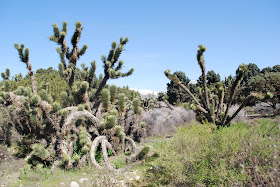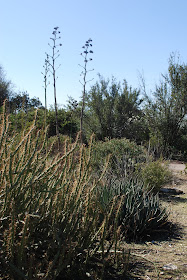 Yucca brevifolias, like rambling, shaggy sculptures in one of the Plant Communities areas at Rancho Santa Ana Botanic Garden.
Yucca brevifolias, like rambling, shaggy sculptures in one of the Plant Communities areas at Rancho Santa Ana Botanic Garden.
Winter seems to have forgotten Seattle, but we still had a 'mid-winter break' from the schools, so I made a short tour to Los Angeles and surroundings with my family. As I walked out from the plane into the glistening sunshine at the tiny Long Beach airport and felt the balmy winds caress my pale cheeks, I once again wondered why we ever left Melbourne and settled into the chilly climates of Stockholm and Seattle, when the southern zones are so much easier for your mind and body...
*

A member of the genus Mimulus, I had misplaced my notes and can't find the right name for this...
**

Arctostaphylos tomentosa, the woollyleaf manzanita, also member of the heather family.
A small mishap on the agenda made my planned visit to Huntington Botanical Gardens impossible, so instead I made a surprise visit to Rancho Santa Ana Botanic Garden in Claremont. Covering over 86 acres, Rancho Santa Ana is the largest botanical garden of California, exclusively dedicated to native California plants. Its was founded in 1927 by Susanna Bixby Bryant, a member of one of California's pioneering families, who was worried about the rapidly disappearing native California flora - an amazingly visionary deed at time when most people and even scholars had no interest for the local plants. Originally founded on her ranch in Orange County, Rancho Santa Botanic Garden was relocated in 1951 to Claremont College campus to be part of its graduate program in botany.
 One of the plantings in the Plant Community areas, with yuccas and cacti.
One of the plantings in the Plant Community areas, with yuccas and cacti.
Located on a plain of the San Gabriel Mountains, the paths are laid out in meandering circles that cover three different areas. Indian Hill Mesa with its dense clay soil is planted with California wild lilacs, Manzanitas and other mature cultivars of native Californian plants. The East Alluvial Garden contains the desert garden and the coastal plant collections, including the Californian Fan Palm Oasis, where native palms have been allowed to keep their skirts of dried, brown fronds; a surprising reminder of how palms really should look like. The third area is the Plant Communities display. Here, Californian natives as cacti, yuccas, pines and the legendary Joshua trees cover a huge 55 acres, all planted in habitats that looked so naturalistic that it was difficult to believe them to have been planted by people.
*  Fremontodendron 'California glory' (flannel bush) in the California cultivar garden, where new varieties of native plants are selected and grown for commercial use.
Fremontodendron 'California glory' (flannel bush) in the California cultivar garden, where new varieties of native plants are selected and grown for commercial use.
 Fremontodendron 'California glory' (flannel bush) in the California cultivar garden, where new varieties of native plants are selected and grown for commercial use.
Fremontodendron 'California glory' (flannel bush) in the California cultivar garden, where new varieties of native plants are selected and grown for commercial use.
Wandering through the winding paths of the Plant Communities, I was happily reminded of some of the hikes I have made in South Eastern Australia and in the Big Sur area in California; so far apart from each other, but still so similar in their nature. Only a few people were out in the gardens, so I was left to my own devices, admiring all the members of Californian plant families, represented there in all hues of green from ashen grey to the deepest emerald. Only some 20 miles away from the bustling LA, Rancho Santa Ana was filled with sparkling birdsong. As the sweet scents from the aromatic plants filled my lungs, I felt well compensated for my disappointment for not seeing the Huntington gardens.
*
 Overview of the Plant Communities area, with San Gabriel Mountains as a majestic backdrop.
Overview of the Plant Communities area, with San Gabriel Mountains as a majestic backdrop.
Very different - well for a European at least. It really does look very natural. A gentle colour scheme that blends so well with the bluish mountains in the background.
ReplyDeleteI was just at the garden yesterday. Very beautiful. I loved all the Mimulus and Ceonothus in bloom.
ReplyDelete